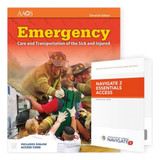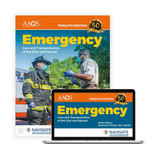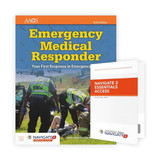Nancy Caroline's Emergency Care in the Streets, 8th Edition includes Navigate 2 Essentials Access
This textbook is a two-volume set that is packaged with Navigate 2 Essentials Access which unlocks a complete audio book, Assessment Center, and dashboard that reports actionable data.
Nancy Caroline’s Emergency Care in the Streets, Eighth Edition is the next step in the evolution of the premier paramedic education program. This legendary paramedic textbook was first developed by Dr. Nancy Caroline in the early 1970s and transformed paramedic education. Today, lead editors Bob Elling and Barb Aehlert, with the American Academy of Orthopaedic Surgeons, are proud to continue this legacy and set the new gold standard for the paramedics of tomorrow.
This fully updated edition covers every competency statement of the National EMS Education Standards for Paramedics with clarity and precision in a concise format that ensures student comprehension and encourages critical thinking. This iconic text emphasizes the ideal that becoming a paramedic is a continual pursuit of growth and excellence throughout an entire career. Concepts of team leadership and professionalism are woven throughout the chapters, challenging students to become more compassionate, conscientious health care professionals as well as superior clinicians.
Evidence-Based Recommendations and Protocols
Medicine is constantly changing and prehospital medicine varies across states and regions. The content of the Eighth Edition reflects the guidance and recommendations of an extremely experienced, geographically diverse group of authors, and its team of Medical Editors from the AAOS. Where possible, content is based on evidence, such as data from the field and studies published in the medical literature.
Current, State-of-the-Art Medical Content
The Eighth Edition meets and exceeds the paramedic National EMS Education Standards and reflects the National Model EMS Clinical Guidelines (NASEMSO), the National Registry Skill Sheets and Psychomotor Competency Portfolio, and Prehospital Trauma Life Support, Eighth Edition, from NAEMT and American College of Surgeons’ Committee on Trauma. Where applicable, the authors and editors followed additional authoritative sources, such as national stroke guidelines. Last but not least, the Eighth Edition thoroughly addresses the 2015 ECC and CPR guidelines published by the American Heart Association. These updates went beyond a compression rate or depth change; the text has been completely updated to reflect all of the Guideline changes.
Strong Application to Real-World EMS
Students who are studying to become paramedics are focused on helping the sick and injured. They need to know why information is important to learn. Through evolving patient case studies in each chapter, the Eighth Edition gives students a genuine context for the application of knowledge. This approach makes it clear how all of this new information will be used to help patients in the field. Opportunities to apply knowledge equip students to ultimately become better providers. Progressive case studies are followed by a comprehensive summary that answers the critical thinking questions raised throughout the case. The You are the Paramedic cases conclude with a Patient Care Report, showing the student exactly how the presented case would be documented.
New to This Edition!
Based on feedback from program directors and educators around the country, we added two new chapters to the Eighth Edition:
- Medical Terminology. Medical Terminology was previously addressed in the Documentation chapter, but educators strongly preferred that we dedicate a standalone chapter to this important topic.
- Career Development. Recognizing that the U.S. health care system, and the role of the paramedic in it, are rapidly evolving, we’ve added a chapter on career development. In addition to discussing the changing and expanding career opportunities for paramedics, this chapter presents nontraditional specialties that paramedics may need in the future to fill evolving roles in the healthcare system.
Table of Contents
- Section 1 preparatory
- Chapter 1 EMS Systems
- Chapter 2 Workforce Safety and Wellness
- Chapter 3 Public Health
- Chapter 4 Medical, Legal, and Ethical Issues
- Chapter 5 Communications
- Chapter 6 Documentation
- Chapter 7 Medical Terminology
- Section 2 The Human Body and Human Systems
- Chapter 8 Anatomy and Physiology
- Chapter 9 Pathophysiology
- Chapter 10 Life Span Development
- Section 3 Patient Assessment
- Chapter 11 Patient Assessment
- Chapter 12 Critical Thinking and Clinical Decision Making
- Section 4 Pharmacology
- Chapter 13 Principles of Pharmacology
- Chapter 14 Medication Administration
- Section 5 Airway Management
- Chapter 15 Airway Management and Ventilation
- Section 6 Medical
- Chapter 16 Respiratory Emergencies
- Chapter 17 Cardiovascular Emergencies
- Chapter 18 Neurologic Emergencies
- Chapter 19 Diseases of the Eyes, Ears, Nose, and Throat
- Chapter 20 Abdominal and Gastrointestinal Emergencies
- Chapter 21 Genitourinary and Renal Emergencies
- Chapter 22 Gynecologic Emergencies
- Chapter 23 Endocrine Emergencies
- Chapter 24 Hematologic Emergencies
- Chapter 25 Immunologic Emergencies
- Chapter 26 Infectious Diseases
- Chapter 27 Toxicology
- Chapter 28 Psychiatric Emergencies
- Section 7 Trauma
- Chapter 29 Trauma Systems and Mechanism of Injury
- Chapter 30 Bleeding
- Chapter 31 Soft-Tissue Trauma
- Chapter 32 Burns
- Chapter 33 Face and Neck Trauma
- Chapter 34 Head and Spine Trauma
- Chapter 35 Chest Trauma
- Chapter 36 Abdominal and Genitourinary Trauma
- Chapter 37 Orthopaedic Trauma
- Chapter 38 Environmental Emergencies
- Section 8 Shock and Resuscitation
- Chapter 39 Responding to the Field Code
- Chapter 40 Management and Resuscitation of the Critical Patient
- Section 9 Special Patient Populations
- Chapter 41 Obstetrics
- Chapter 42 Neonatal Care
- Chapter 43 Pediatric Emergencies
- Chapter 44 Geriatric Emergencies
- Chapter 45 Patients With Special Challenges
- Section 10 Operations
- Chapter 46 Transport Operations
- Chapter 47 Incident Management and Mass-Casualty Incidents
- Chapter 48 Vehicle Extrication and Special Rescue
- Chapter 49 Hazardous Materials
- Chapter 50 Terrorism Response
- Chapter 51 Disaster Response
- Chapter 52 Crime Scene Awareness
- Section 11 Career Development
- Chapter 53 Career Development













